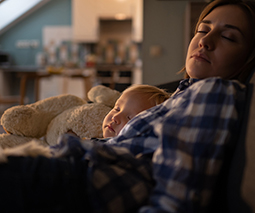Co-sleeping but want out? Here’s how you can do it successfully

Co-sleeping with your little one but dreaming of getting your bed back to yourself? Mothercraft nurse, Chris Minogue know what to do.
Personal experience
When we brought our second son home from the hospital, I was determined to co-sleep. Our first baby was in another room from day one and never a great sleeper, so I figured this was the solution I had overlooked.
In some ways, I was right. The first six months of his new life was relatively painless, until the reflux systems started, followed by teething and then a course of normal developmental milestones which meant at the very worst of times, I was feeding an almost one-year-old up to six times overnight.
Right about then I decided we had a problem.
Backing out of co-sleeping is not as simple as it sounds
Chris says that to make a successful shift, all members of the family need to be on board with the decision.
“Remember all they know about sleeping is co-sleeping. A dark room without another body in it is a big change,” she says.
“You need to start by thinking about what the child already knows about sleep and how you can mimic those conditions in the best possible way.”
Transitioning out of co-sleeping requires a series of well-considered steps and of course, depends on the age of your child. Chris shares three steps for getting started;
- Start by getting your child to self-settle in the shared bed.
- Move a cot into the room and put it near your bed so your child can still smell and see and hear you at night. For older children, you can put a mattress on the floor beside your bed. Do this for a month.
- After a month has passed, move your child into the room where you want them to sleep in their cot or bed.
“Be prepared for at least five to seven days of unsettled nights at this time,” warns Chris. “This will be the hardest of the transitions for your child and may require you to give extra cuddles. Older children can benefit from soft toys during this time.”
For our family, the transition took about three months
We started when our youngest had just turned one, but because our boys shared a room and our older son is three years older than his brother, we needed the move to benefit both their sleep cycles.
On Chris’s advice, we moved a cot into our room and our baby slept there for about two months, getting used to not being actually next to me.
When it came time to move him into the next room, we moved our older son into our room and my husband spent two weeks getting up and re-settling the baby. After one week he was sleeping from 7pm to 4:30am without too much fuss, and by the second week he was just about making it to 6am.
Rules for parents and supporting family members
Everyone needs to be consistent with the new routine during the transition. Chris says it’s important to be patient and provide lots of reassurance.
“Be respectful of your decision – remember that you chose to co-sleep for a reason, so you need to be prepared to take your time and have patience, to help your child how to sleep in a totally new environment,” she explains.
Our “baby” is now 20 months and while we still put the boys to bed at separate times, they share a room with no problem, and he is sleeping till 6:30am most days.
Touch wood (insert panic emoji)!
 Need some more baby sleep advice? Our Parent School sleep experts can help. Click to find out more or book a one-on-one session.
Need some more baby sleep advice? Our Parent School sleep experts can help. Click to find out more or book a one-on-one session.









